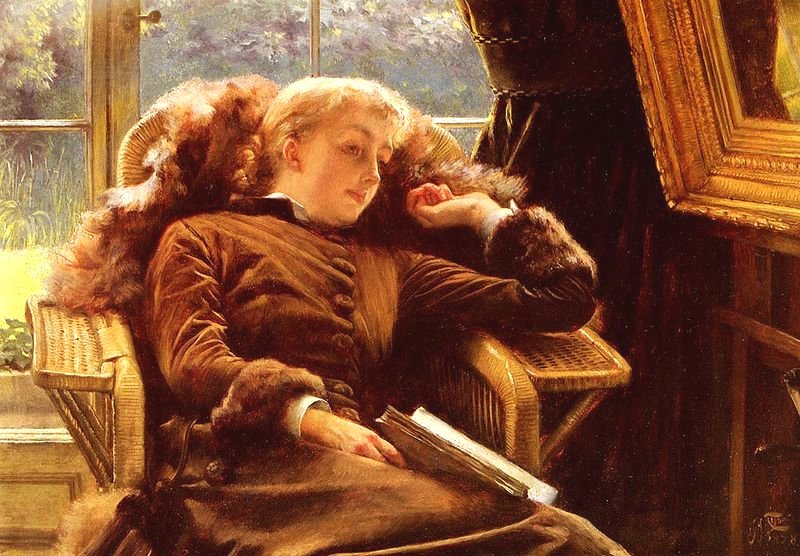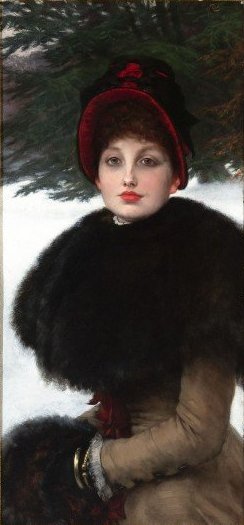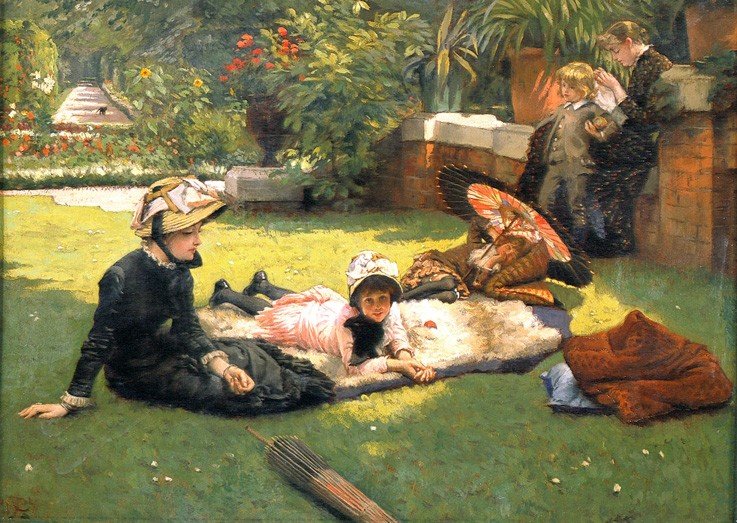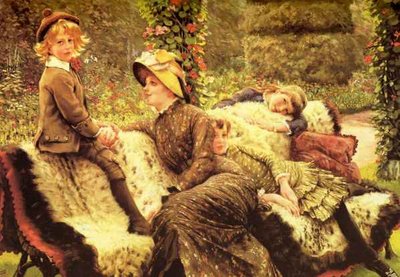
My blog today is the second part of the life of the French painter James Tissot. In my last offering I looked at one of his beautiful and unusual religious paintings and I told you a little about the life of the artist but purposely left out his relationship with the special lady in his life, which I wanted to save for today.
In 1870 France was in turmoil. The Franco-Prussian war had broken out, which was the conflict between France, under Napoleon III and the Kingdom of Prussia and was the final straw in the conflict between the two nations. France was defeated and Paris was eventually occupied by the Prussian army. Tissot was a member of the Garde Nationale which was tasked with defending the French capital and later became a member of the Paris Commune, which was a quasi-government that briefly ruled Paris and acted as protectors of the Parisians and their property from March to May in 1871. However, Tissot, whether through business reasons or concerns he had for his personal safety, decided to leave his homeland and that year went to England where, through his art, he had built up a network of friends and business contacts. One of these was Thomas Gibson Bowles, the proprietor of the popular magazine Vanity Fair. Bowles not only provided Tissot with a place to stay in London but he also employed him as a caricaturist on the magazine. Whilst in London Tissot also exhibited at the Royal Academy. As was the case when he was in France, Tissot depicted in his paintings many of the chic ladies of London and he was a genius in the way he depicted them bedecked in the most expensive and sumptuous clothing which he carefully detailed. These paintings were very popular and soon, through their sales, he managed to buy his own house in St John’s Wood, which, at that time, had become a popular and much sort after enclave for artists. Tissot was not only admired as a great artist by the London Society but through the auspices of Thomas Bowles he was given entry into the social and artistic circles of London.
This particular time, 1874, was the starting point for the French Impressionists and his friend Degas tried to persuade Tissot to exhibit at their first exhibition but he declined the offer. His decision to refuse to exhibit did not in any way cut him off from his Impressionist friends as he remained great friends with Berthe Morisot who visited him at his London home and also he remained very friendly with Edouard Manet. The following year, 1875, the two travelled to Venice on a painting trip. It was around 1875 that he first met Kathleen Newton, a stunningly beautiful divorcee and it was Tissot’s relationship with her that afforded him, as an adult, his only period of a real family life. She would dominate the subject matter of his paintings.

Kathleen Irene Ashburnham Kelly was born in 1854 and brought up in Lahore and Agra. She was the youngest of five children and came from an Irish Catholic family. Her grandfather, Charles Kelly, left Ireland and practiced medicine in London. His son, and Mary’s father, Charles Frederick Kelly joined the East India Company and was stationed in Lahore where he worked as a clerk. He married Flora Boyd, whose family came from the North of Ireland, and the couple had five children, Charles (Charley), Frederick WD (Freddie), George Lloyd (George), Mary Pauline (Polly) and Kathleen Irene (Kate). In 1858, Charles Kelly, who had now added the family name “Ashburnham” to his own name, was transferred to Agra. Kathleen’s father finally achieved the rank of chief adjutant and accountant officer in Agra and eventually retired around 1865, left India and returned with his wife and daughters to live in London. When Kathleen was sixteen she travelled back to India to marry Isaac Newton, who was a surgeon attached to the Indian Civil Service. This was to be an arranged marriage orchestrated by her father and she had little or no input into the choosing of her future husband.
During the sea passage to India she was befriended by a Captain Palliser of the Bengal Rifles regiment who was returning to the sub-continent to rejoin his regiment. (Other versions of her life state that Palliser, although a captain, was a naval officer). Their friendship grew during the long sea passage and they became lovers and despite his pleas to her to cancel her wedding plans, she and Isaac were married in January 1870. Being a devout Catholic, Kathleen decided to tell the local priest of her affair with Captain Palliser. For him to forgive her of her sins the priest told her she should first tell her husband about this relationship. She took the priests advice and told her husband who was horrified and as their marriage had not been consummated; her husband immediately instigated divorce proceedings on the grounds that his wife had not been a virgin on her marriage day. Kathleen returned to England, the sea passage being paid for by the lovestruck Captain Palliser, who accompanied her, as a gesture of good will for her agreeing to be his mistress. Their affair continued and she became pregnant but still refused to marry him. When she arrived back in England she went to stay with her father, who was at the time courting a widow. Kathleen’s daughter Muriel Mary Violet Newton was born there on 20 December 1871, which was also the same day as her Decree Nisi came through. Later Kathleen and her daughter Violet went to live with her sister Polly and her husband at Hill Road, St John’s Wood.

It was about four years later around 1875, that James Tissot, who was also living in St John’s Wood, London, met Kathleen Newton née Kelly. The next step in their relationship came in March 1876 when Kathleen gave birth to a son, Cecil George Newton Ashburnham, who it is believed had been fathered by Tissot. Kathleen and James Tissot became lovers and she moved in with Tissot. (It should be noted that census records cast some doubt whether they lived together and it is thought that Kathleen’s two children spent most or all of their time living with their aunt Polly and her family). For Tissot, as was the case with Captain Pallister some five years earlier, he was smitten by this stunningly beautiful young woman. His terms of endearment for her were mavoureen (Irish Gaelic for my love) and his native French phrase ravissante Irlandaise (lovely Irish). Kathleen Newton became the love of Tissot’s life, his muse and adored lover. Tissot described his time with Kathleen as one of “domestic bliss” and the happiest times of his life. He completed many paintings featuring Kathleen of which I have featured some in my blog today.

There was one great setback with his relationship with Kathleen for James Tissot. Although it was not uncommon for successful and wealthy men to keep a mistress they did not, like Tissot, parade them around openly and advertise their liaison. Tissot’s open and very public display of his affair with Kathleen shocked the London society which had once welcomed him with open arms and he had to choose between his social life and Kathleen. For Tissot there was no question as to which course of action he would choose. Kathleen was the love of his life and he chose her over life amongst London society. He and Kathleen settled down to a life of domesticity and were happy to mix with their many artistic friends who continued to support them. They never married and this may be due to their rigid Roman Catholic upbringing and beliefs.

This charming painting shows Kathleen sitting on a rug in the garden next to her daughter Violet. The other small girl holding the parasol is her niece, Lillian Hervey. Sitting on the wall is her sister, Mary Hervey (Polly), who you can see ruffling the hair of Cecil George Newton who is thought to be the son of James Tissot.
————————————————————————————————————————————–
In the late 1870s Kathleen’s health started to deteriorate with the onset of tuberculosis. Tissot remained devoted to her. In 1882, Kathleen’s health declined rapidly with the onset of consumption. The illness gave her great pain and Tissot was visibly distraught by the physical state of his wife and her sufferings. Kathleen was aware that she was dying and she was saddened to witness how heartbroken her husband was, witnessing her long lingering death and so in November 1882, aged just twenty eight, she took an overdose of laudanum and died. Sadly because she had committed suicide she was not able to be buried in consecrated ground.

The painting above shows Kathleen Newton and her children, Cecil George and Violet and her niece, Lilian Hervey, the daughter of her sister Polly. Although Tissot exhibited the painting, he would not sell it and kept it with him as a memorial until his death.
————————————————————————————————————————————–
One week after Kathleen’s death, Tissot left his London home at St John’s Wood, and never returned to it. The house was later bought by the artist Alma-Tadema. Tissot was inconsolable and never really recovered from Kathleen’s death. Tissot never married and like many people who are devastated by the loss of a loved one he turned to Spiritualism, and on a number of occasions tried to contact his beloved Kathleen.
This somewhat sad story about a French artist and his fallen women is one of the great 19th century English love stories. My interest in James Tissot was born out of a comment I received from Lucy Paquette who said she was publishing an eBook this autumn, entitled Hammock, a novel based on the life of James Tissot. I hope, like me, you will be looking out for this publication.
Patricia O’Reilly has also written a novel about Kathleen Newton entitled A Type of Beauty: The Story of Kathleen Newton (1854-1882) which I am hoping to buy as novels based on lives of artists or one of their paintings always fascinate me.

Hi, Lydia,
Thank you for this tremendous blog post and the gorgeous images with which you illustrate it. So beautifully and brilliantly done! Everyone who enjoys your posts is lucky for the scholarship and time you lavish on them.
I so appreciate your mention of The Hammock: A novel based on the true story of French painter James Tissot. It will indeed be available for e-readers this fall, and you will be one of the first to know the date.
Although his stunning paintings are still as popular with people today as they were in his heyday, James Tissot is not now a well-known figure like his friends Jimmy Whistler, Edgar Degas and Édouard Manet, who did not enjoy the material success during their lifetimes that Tissot did. THE HAMMOCK, based on contemporary sources, brings Tissot’s world alive in a story of war, art, Society glamour, love, scandal, and tragedy.
In addition to la belle Irlandaise — Kathleen Newton — The Hammock’s cast of characters includes Jimmy Whistler, Edgar Degas, Édouard Manet, Oscar Wilde, Louise Jopling, J.E. and Effie Millais, Lawrence Alma-Tadema, the Prince of Wales, Berthe Morisot, Thomas Gibson Bowles and many other figures of the dynamic 1870’s during the birth of modern art in London and Paris.
Half the fun of Art History is learning the stories behind the creations, and the other half is looking at the art itself. You facilitate both with your excellent blog. For your readers, here is a website that shows more of Tissot’s work — http://www.jamestissot.org. I have a Pinterest Board of Tissot images that anyone can view, and I’m working on a blog (on wordpress.com), where you can follow the stories behind the story!
Lucy Paquette
TheHammockNovel@aol.com
Hello Lucy,
Thanks for Brilliant comments on Lydia’s post re Tissot & Newton. I am author of A Type of Beauty, the story of Kathleen Newton – currently long listed for Historical Novel Society award. Good luck with all your writing – Patricia O ‘Reilly
Patricia, so good to hear from you! I’ll contact you via your website.
Lucy Paquette
Hi, Jonathan,
Thank you for this tremendous blog post and the gorgeous images with which you illustrate it. So beautifully and brilliantly done! Everyone who enjoys your posts is lucky for the scholarship and time you lavish on them.
I so appreciate your mention of The Hammock: A novel based on the true story of French painter James Tissot. It will indeed be available for e-readers this fall, and you will be one of the first to know the date.
Although his stunning paintings are still as popular with people today as they were in his heyday, James Tissot is not now a well-known figure like his friends Jimmy Whistler, Edgar Degas and Édouard Manet, who did not enjoy the material success during their lifetimes that Tissot did. THE HAMMOCK, based on contemporary sources, brings Tissot’s world alive in a story of war, art, Society glamour, love, scandal, and tragedy.
In addition to la belle Irlandaise — Kathleen Newton — The Hammock’s cast of characters includes Jimmy Whistler, Edgar Degas, Édouard Manet, Oscar Wilde, Louise Jopling, J.E. and Effie Millais, Lawrence Alma-Tadema, the Prince of Wales, Berthe Morisot, Thomas Gibson Bowles and many other figures of the dynamic 1870’s during the birth of modern art in London and Paris.
Half the fun of Art History is learning the stories behind the creations, and the other half is looking at the art itself. You facilitate both with your excellent blog. For your readers, here is a website that shows more of Tissot’s work — http://www.jamestissot.org. I have a Pinterest Board of Tissot images that anyone can view, and I’m working on a blog (on wordpress.com), where you can follow the stories behind the story!
Lucy Paquette
TheHammockNovel@aol.com
i want to thank you for this beautiful story, i came here because i have been searching for info on my 2nd great grandfather George Lloyd Ashburnham Kelly (abt 1851) who as i have found out from your story is Kathleen’s brother. been researching my ancestry and through your story got far more than i bargained for, so again thankyou
Whatever happened to his children though?